WEDNESDAY'S SCRIPT TIP:
PICK UP THE PACE

Our job as screenwriters is to rupture bladders.
The audience has just spent $7 on a king sized Coca-Cola with free refills, which is almost empty about halfway through the film (they started drinking it while watching all of those ads before the movie). Now they're looking for that dead spot in the story so that they can run to the bathroom. That part of the film where nothing interesting is happening and doesn't seem likely to happen for a couple of minutes. Just long enough to race to the restroom and race back. Our job is to make sure there are no dead spots, no slow spots, no time to race to the restroom... so that there is at least one messy bladder explosion at every showing.
The pacing of your script is critical. We have all seen movies that had those dull sections where nothing seemed to be happening, and we've all seen movies that just dragged along. Though a compelling story might make a slow paced film tolerable, it's still a slow paced film. Pacing is one of the most important elements of a screenplay, yet you seldom see it mentioned in screenwriting books or screenwriting classes. What *is* pacing?
Pacing is the frequency of exciting events in your screenplay (or in the movie). The more exciting events, the faster paced your screenplay. The fewer exciting events, the slower paced your screenplay. Pretty simple.
For the most part, the exciting events will be what I call the "genre juice" - those juicy genre scenes that people buy tickets to see. Those scenes that make it into the trailer. In a comedy, those are the comedy set pieces. In action they are the action scenes. In a thriller they are the suspense scenes. Though we all want great characters and a great story, the reason why we go to a comedy film is to laugh - so the funny scenes are critical. You need enough funny scenes in a comedy so that those folks who bought that $7 soft drink can't make a dash for the restroom because they don't want to miss all of those funny things that they know are coming, because the film so far has been filled with funny scenes. We pay to see a comedy film because it's funny - so the script better bring that funny and keep us laughing. If you have a comedy script with five funny scenes out of 50-60 scenes, that's not very funny. Nothing to keep you from visiting the bathroom or the candy counter or even playing that video game in the theater lobby.
SCENE NUMBERING

One of the reasons why your script is slow paced may be that not enough is happening - and you have a padded script. The average script is going to have somewhere between 50 and 60 scenes - and the average is probably closer to 60. If you do the math, that means your average scene is going to be about 2 pages. Now, that's an average, so you may have some 4 page scenes and some 1 page scenes, but if your script ends up with 10 page scenes? You might want to take a look at those epic scenes and see if they really need to be that long. A ten page scene is likely to slow down the script just because it is ten pages about the same thing.
Most new writers have no idea how faced paced a movie really is and how long 10 minutes of screentime is - a good exercise is to time movies: watch a movie and write down what all of the scenes are and what time they take place. My DVD player has a running time feature that starts at 0 and shows how many minutes have passed since the film began - a great tool when timing movies. Once you've timed a few movies, you realize how much story is packed into a screenplay - it's a lot! Then apply that to your screenplay - make sure you have just as many thing happening. Look at the length of those scenes from the movies you have timed - you'll probably noticed some jam-packed half minute scenes! There's that old story about Billy Wilder rewriting a 10 page dialogue scene into a half page that contained every single piece of information from the longer version. That's one of the basics of screenwriting - it's *condensed writing*. You need to find the way to get the maximum amount of information across in the minimum amount of screen time, because we only have 110 pages to tell the entire story.
Many slow paced films (and their screenplays) are really 60 minutes of movie story expanded to 110 pages... and that means almost half of the script is some form of filler material or just sluggish writing. Make sure you have enough story and make sure you don't spend 5 pages on a 2 page scene.
TACKED ON PACING
There are two ways to insure that your script is well paced:
1) Include the pacing in your outline so that it becomes part of the structure.
2) Edit and rewrite your script once it is finished to improve pacing.

If you include the pacing in your outline, you have "built in pacing", if you try to create pacing after the fact you may end up with contrived pacing... plus a whole lotta rewriting! I have seen many action films where it seems like someone just threw in a gratuitous car chase because the pace was lagging. That's usually what happens when pacing is an after thought - the scenes stuck-in during rewrites stick-out like a sore thumb! That is why I prefer to build my action scenes (or whatever the "genre juice" is) into the outline, so that they are part of the story itself. The juice scenes become part of the story's skeleton, not something I stick on in a rewrite that wasn't part of the original story.
It also helps to think about the juice scenes when you are looking for story ideas and thinking about characters. Though a car chase is an exciting scene that may be in the trailer and may get the audience to pay for the ticket and may keep them from making that mad dash to the restroom, it is also a *character scene* and a *story scene*. Your protagonist is in trouble and must make life or death situations in a car chase, so think of the juice scenes as character scenes as well. They aren't just something to keep the story exciting, they are also scenes of conflict that will expose character. That's another reason why those pasted on action scenes (or comedy scenes or romance scenes or suspense scenes) do not work - they are not part of the protagonist's emotional journey and not part of the story.
You want to build the juice scenes into your story so that the hysterical comedy set piece is a required part of the character's story and can not be removed. Any scene that *can* be removed, *should* be removed... so any scene you can just tack onto your script is a scene that doesn't belong in your script. You want to make sure that all of those exciting "juice scenes" are integral to the story.
Is there a rhythm to the placement of the scenes (or are there long dead spots where nothing exciting happens)? Does the action or suspense or humor snowball and intensify? If your comedy becomes LESS funny as it progresses, you're in a heap-o-trouble. Pacing should intensify, not grow limp. Remember, our job is to rupture bladders. The more the audience has to go to the bathroom, the more we have to do to keep them in their seats. By Act Three there shouldn't be a minute to spare!
ACT THREE PACING

A 110 page script will have around 12 "genre juice" scenes... maybe more. Act Threes in action and thriller scripts are often "out of the frypan, into the fire" -- one action scene leads to the next and they keep snowballing until you reach the end. FACE/OFF's Act Three is wall-to-wall action, starting with a shoot out in a church between the Hero and Villain, turning into a stand off where the Villain kidnaps the Hero's daughter and holds a gun to her head outside the church, which leads to a foot chase on the pier near the church, which snowballs into the Villain stealing a speedboat and the Hero giving chase in a speedboat, which turns into a fist fight (with anchors and chains) onboard the Villain's boat, then the Villain's boat hits the shore and explodes, throwing Hero and Villain onto the beach, where they have a final knife-vs.-speargun fight. One action snowballs into the next in a continuous act-o-action.
Thrillers often do the same thing - Act Three of WAIT UNTIL DARK is one big game of hide-and-go-seek between the killer and the blind woman.
Comedy scripts also usually have "out of the frypan" Act Threes... just with one funny situation snowballing into the next. Check out the end of BLAZING SADDLES or THERE'S SOMETHING ABOUT MARY or MY BEST FRIEND'S WEDDING for some good examples.
In another tip on how pacing is the heartbeat of your script, I say that just as your heart beat increases as you become excited, the frequency of exciting scenes will increase when your script becomes more exciting. You will probably have many more juice scenes in the third act of your script than in the first act. Make sure you don't use up all of the excitement before the end of your story! The one place where you don't want slow pacing is Act Three. They really have to visit the restroom, and you have to fight twice as hard to prevent that from happening!
ALL JUICE ALL THE TIME?

Hey, if a "juice scene" within every ten pages is good, wouldn't a 20 minute wall-to-wall "juice scene" be even better? The answer is... no.
Films with all exciting scenes one after another seem to burn out - too much of a good thing. A script needs balance - peaks and valleys. If your script is always exciting, we'll become used to the excitement and it will becomes expected... and what's expected is not exciting. When car chases and shoot outs becomes boring, you're in trouble! All excitement is as much of a problem as no excitement at all.
When you look at the heart monitors on medical shows (or your latest trip to the ER because your bladder exploded in the cinema) you'll notice a heart beat goes up and down - there are peaks and valleys. The same is true with script pacing - you don't want all peaks, because that's just as much a flatline as all valleys. You want a peak followed by a valley - an action scene followed by a non-action scene. That keeps the action scenes exciting. But how do you keep them from making a mad dash to the restroom after the car chase is over?
Well, first you need to make sure the scenes that are not "genre juice" are critical to the story and critical to the protagonist's emotional journey. Thinking that a "genre juice" car chase is just some sort of filler material is a huge mistake... as is thinking that the scenes between your "genre juice" scenes are some sort of filler material. There is no filler material in a screenplay - every single scene, every single page, every single word is required to tell the story and had better be interesting and exciting. Remember, there *are* other forms of excitement other than a car chase. Interesting characters are exciting.

Here's what I learned from watching ABBOTT & COSTELLO MEET FRANKENSTEIN: One genre's valley is another genre's peak. By combining two genres - horror and comedy - ABBOTT & COSTELLO MEETS FRANKENSTEIN is twice as exciting, with no burn out factor. The valleys in the horror are peaks in the comedy. When you aren't screaming, you're laughing. The comedy makes the horror twice as scary because it becomes unexpected. Here you are laughing and then something frightening happens. The horror also makes the comedy twice as funny for the same reason - after a big scare you really *need* a good laugh!
That tradition is what makes many 1980s horror movies (from AMERICAN WEREWOLF to THE HOWLING to HOUSE) so scary - the valleys in the horror story were peaks in the comedy story, and the stories never lost their focus on *characters*. An exciting scene happing to people we don't care about isn't very exciting. The peaks-and-valleys thing was also used with romance in many 1940s horror flicks like CAT PEOPLE and I WALKED WITH A ZOMBIE, which became more scary because they are love stories. There's this big romantic scene... and in the middle of a kiss the monster attacks. So when a horror film isn't scary, it's not dull... it's exciting in some other way.
The "default genre" of all scripts is usually drama - your protagonist is struggling with some emotional problem which is amplified by a physical problem (plot) that is in a popular genre. So the "genre juice" scenes may be action or thriller or comedy or horror or rom-com, but the "valley scenes" will usually be dramatic. If you look at the BOURNE movies, that is a serious character oriented story... with massive car chases. I have a tip in rotation on drama as default genre that uses a couple of comedies as examples - when those films aren't making you laugh outloud, they are about characters struggling with serious emotion problems. This is one of the reason why straight dramas usually don't do as well as genre films - the "genre juice" scenes in a drama are those big dramatic moments... those are the peaks. So what are the valleys? Um, usually nothing.

Hitchcock said "Movies are life with all of the dull bits cut out" - so you want your script to always be interesting and involving... just not always juice scenes from your primary genre (that would be all peaks = no peaks). There are no peaks if you don't have valleys - but that doesn't mean the valleys have to be dull.
Don't think of valleys as "dull spots" or "slow spots", they're going to be exciting spots in some other genre. Your thriller may use the valleys as peaks in a dramatic story. Your comedy valleys may be romantic peaks... or thriller peaks... or horror peaks... or action peaks... or some other emotional and exciting type of scene that compliments the genre of your script and helps to explore character. Every page of your script needs to be interesting, emotionally involving and exciting.
Every scene, every page... needs to be exciting!<
BRAND NEW!
How Do I do That?

101 SCREENWRITING ANSWERS Blue Book!
New to screenwriting? You probably have questions! How do I get an Agent? How do I write a phone conversation? Do I need a Mentor? What’s does VO and OC and OS mean? What is proper screenplay format? Should I use a pen name? Do I need to movie to Hollywood? What’s the difference between a Producer and a Production Manager, and which should I sell my script to? How do I write a Text Message? Should I Copyright or WGA register my script? Can I Direct or Star? How do I write an Improvised scene? Overcoming Writer’s Block? How do I write a Sex Scene? And many many more! This book has the answers to the 101 Most Asked Questions from new screenwriters! Everything you need to know to begin writing your screenplay!
All of the answers you need to know, from a working professional screenwriter with 20 produced films and a new movie made for a major streaming service in 2023!
Only $4.99
NEW!!!
Can You Make It bigger?

BLOCKBUSTERS (and BEACH READS) Blue Book!
Writing something EPIC?
ONLY: $4.99!
Thinking about writing a big Disaster Movie? An Historical Epic? An Epic Adventure Film? Or maybe you like Gladiator Movies? This book looks at writing Blockbusters and those Big Fat Beach Read novels - anything epic! Usng movies like JAWS, POSEIDON ADVENTURE, LAWRENCE OF ARABIA, THE GUNS OF NAVARONE, and those MARVEL and FAST & FURIOUS flicks as examples. What *is* a Blockbuster? 107 years of Blockbuster history! Blockbuster Characters. Blockbuster Story Types! Why modern Blockbusters are soap operas! Social Issues in Blcokbusters? Big Emotions! Keeping All Of Those Characters Distinctive! How to avoid the Big problems found in Big Movies and books! More! If you are writing a Big Event Movie or a Big Fat Novel, there are tips and techniques to help you!
Only $4.99
BRAND NEW!
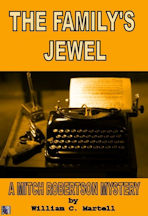
***
MITCH ROBERTSON #2: THE FAMILY'S JEWEL *** - For Kindle!
"The Presidential Suite of the Hollywood Hoover Hotel looked like a bloody battlefield: bodies everywhere, furniture broken, red liquid dripping from the walls, dead soldiers littering the elegant Berber rug as clouds of smoke overhead bounced between two air conditioning vents.
Mitch Robertson stepped over the body of an ex-child star turned sex tape star turned pop star and entered the room, spotted a gun on the floor and picked it up... careful not to spill his coffee with three pumps of mocha syrup from Penny’s Coffee Shop. That coffee was gold, the only thing keeping him going in this dazed state of wakefulness. The gun felt light. Holding it, he saw the silhouette of an 80s action star sitting sideways on a tipped over chair. Motionless. Was he dead? Mitch was still hung over from the Awards Party the night before, and wondered whether this was all some sort of crazy nightmare that he would wake up from... but when he tripped over the brown legs of a bottomless Superhero, flaccid junk encased in a condom but still wearing his mask, and hit the edge of the sofa, gun skittering and coffee spilling, he realized that it was all very real. What the hell had happened here?"
Short Novel. Only 99 cents - and no postage!
IT'S NEW!!
All About Rewrites!
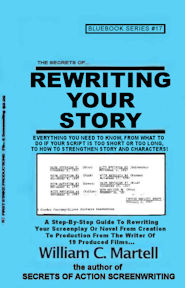
REWRITES Blue Book!
Rewriting In Waves?
When You Finish Your Screenplay Or Novel...
The Rewrites Begin!
The end is just the beginning! You’ve finished your story, but now the rewriting begins! This 405 page book shows you how to rewrite your screenplay or novel to perfection. Everything from Character Consistency to Shoeboxing to How To Give And Receive Notes to 15 Solutions If Your Script’s Too Long! and 15 Solutions If Your Script’s Too Short! to Finding The Cause Of A Story Problem to Good Notes Vs. Bad Notes to Finding Beta Readers to Avoiding Predictability to Learning To Be Objective About Your Work to Script Killer Notes and Notes From Idiots to Production Rewrites and What The Page Colors Mean? and a Complete Rewrite Checklist! The complete book on Rewriting Your Story!
Only: $4.99
HITCHCOCK FOR WRITERS!
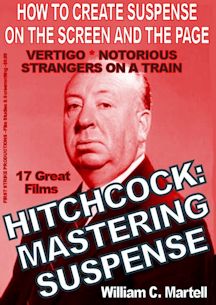
LEARN SUSPENSE FROM THE MASTER!
*** HITCHCOCK: MASTERING SUSPENSE *** - For Kindle!
Alfred Hitchcock, who directed 52 movies, was known as the *Master Of Suspense*; but what exactly is suspense and how can *we* master it? How does suspense work? How can *we* create “Hitchcockian” suspense scenes in our screenplays, novels, stories and films?
This book uses seventeen of Hitchcock’s films to show the difference between suspense and surprise, how to use “focus objects” to create suspense, the 20 iconic suspense scenes and situations, how plot twists work, using secrets for suspense, how to use Dread (the cousin of suspense) in horror stories, and dozens of other amazing storytelling lessons. From classics like “Strangers On A Train” and “The Birds” and “Vertigo” and “To Catch A Thief” to older films from the British period like “The 39 Steps” and “The Man Who Knew Too Much” to his hits from the silent era like “The Lodger” (about Jack The Ripper), we’ll look at all of the techniques to create suspense!
Only $5.99
NO KINDLE REQUIRED! Get the *free* app (any device, except your Mr. Coffee) on the order page on Amazon!
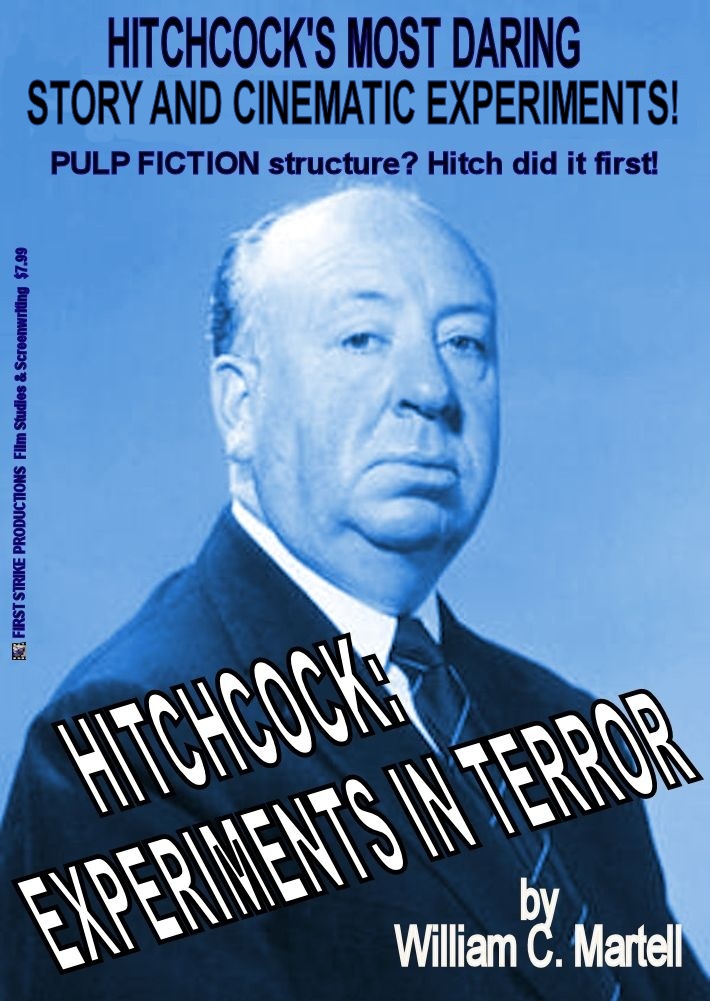
Strange Structures!
*** HITCHCOCK: EXPERIMENTS IN TERROR! *** - For Kindle!
***
Contained Thrillers like "Buried"? Serial Protagonists like "Place Beyond The Pines"? Multiple Connecting Stories like "Pulp Fiction"? Same Story Multiple Times like "Run, Lola, Run"?
HITCHCOCK DID IT FIRST!
This book focuses on 18 of Hitchcock's 52 films with wild cinema and story experiments which paved the way for modern films. Almost one hundred different experiments that you may think are recent cinema or story inventions... but some date back to Hitchcock's *silent* films! We'll examine these experiments and how they work. Great for film makers, screenwriters, film fans, producers and directors.
Only $5.99 - and no postage!
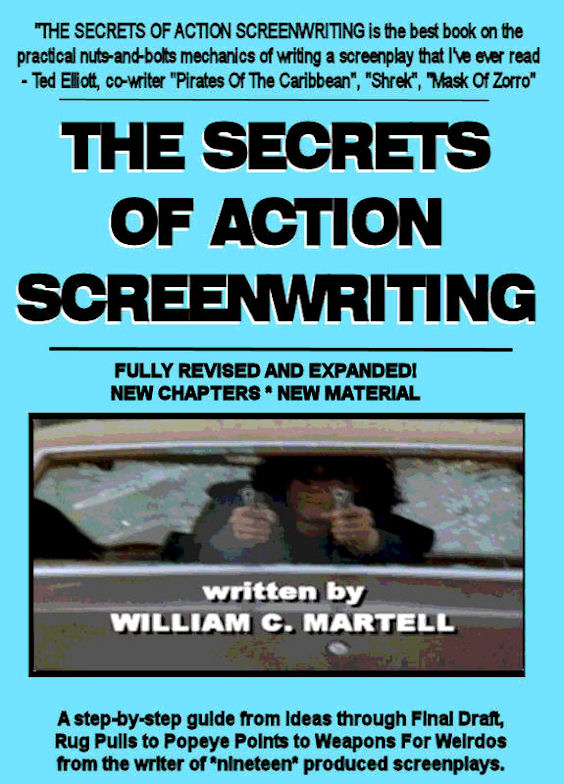
MAKES A GREAT GIFT!
*** THE SECRETS OF ACTION SCREENWRITING *** - For Kindle!
*** THE SECRETS OF ACTION SCREENWRITING *** - For Nook!
Why pay $510 for a used version of the 240 page 2000 version that used to retail for $21.95? (check it out!) when
you can get the NEW EXPANDED VERSION - over 500 pages - for just $9.99? New chapters, New examples, New techniques!
"SECRETS OF ACTION SCREENWRITING is the
best book on the practical nuts-and-bolts mechanics of writing a screenplay I've ever read."
- Ted Elliott, co-writer of MASK OF ZORRO, SHREK, PIRATES OF THE CARIBBEAN and the sequels (with Terry Rossio). (ie; 4 of the top 20 Box Office Hits Of ALL TIME.)
Only $9.99 - and no postage!
Tip FAQ

My New Script Secrets Newsletter!

STORY IN ACTION SERIES!

THE MISSION IMPOSSIBLE MOVIES
NEW: Updates On Films 7 & 8 Casting!
All Six Movies analyzed! All of the mission tapes, all of the “that’s impossible!” set pieces and stunts, the cons and capers - and how these scenes work, the twists and double crosses, the tension and suspense (and how to generate it), the concept of each film as a stand alone with a different director calling the shots (broken in the sixth film), the gadgets, the masks, the stories, the co-stars and team members (one team member has been in every film), the stunts Tom Cruise actually did (and the ones he didn’t), and so much more! Over 120,000 words of fun info!
THE MISSION IMPOSSIBLE MOVIES - 347 Pages - Only $3.99 !

BRAND NEW!
*** THE BOURNE MOVIES
NEW: Updates on TREADSTONE TV show!
All five "Bourne" movies (including "Legacy" and it's potential sequels) - what are the techniques used to keep the characters and scenes exciting and involving? Reinventing the thriller genre...
or following the "formula"? Five films - each with an interesting experiment! A detailed analysis of each
of the films, the way these thrillers work... as well as a complete list of box office and critical
statistics for each film. This book is great for writers, directors, and just fans of the series.
Only $3.99 - and no postage!
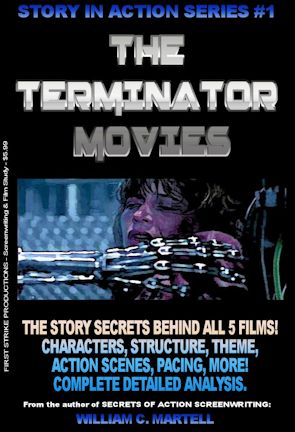
Over 240 pages!
*** THE TERMINATOR MOVIES *** - For Kindle!
He's back! The release of "Terminator: Dark Fate" is set to begin a new trilogy in
the Terminator story... 35 years after the first film was released. What draws us to these films about
a cybernetic organism from the future sent back in time? Why is there a new proposed trilogy every few
years? This book looks at all five Terminator movies from a story standpoint - what makes them work
(or not)? What are the techniques used to keep the characters and scenes exciting and involving? How
about those secret story details you may not have noticed? Containing a detailed analysis of each of
the five films so far, this book delves into the way these stories work... as well as a complete list of
box office and critical statistics for each film. This book is great for writers, directors, and just
fans of the series.
ONLY $3.99 - and no postage!
NO KINDLE REQUIRED! Get the *free* app (any device, except your Mr. Coffee) on the order page on Amazon!

NEW BUT OLD!
*** VINTAGE #1: HOW TO WRITE PHOTOPLAYS *** - For Kindle!
***
Screenwriting books have been around as long as films have. This series reprints vintage screenwriting books with a new introduction and history, plus new articles which look at how these lessons from almost 100 years ago apply to today’s screenplays. Anita Loos book is filled with information which still applies.
In addition to the full text of the original book, you get the full screenplay to Miss Loos' hit THE LOVE EXPERT, plus several new articles on the time period and women in Hollywood.
Only $2.99 - and no postage!
THE BLUE BOOKS!
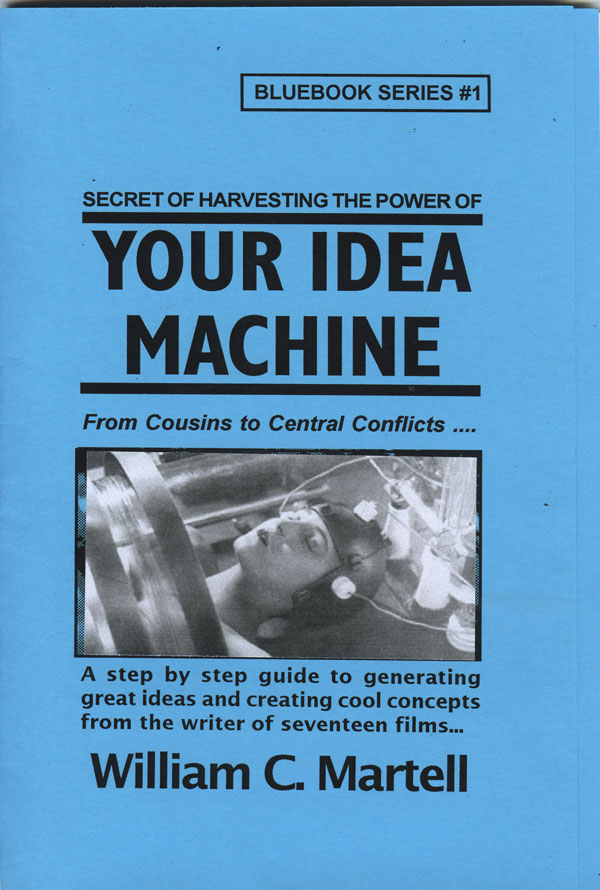
FIND A GREAT IDEA!
*** YOUR IDEA MACHINE *** - For Kindle!
****
Expanded version with more ways to find great ideas! Your screenplay is going to begin with an idea. There are good ideas and bad ideas and commercial ideas and personal ideas. But where do you find ideas in the first place? This handbook explores different methods for finding or generating ideas, and combining those ideas into concepts that sell. The Idea Bank, Fifteen Places To Find Ideas, Good Ideas And Bad Ideas, Ideas From Locations And Elements, Keeping Track Of Your Ideas, Idea Theft - What Can You Do? Weird Ways To Connect Ideas, Combing Ideas To Create Concepts, High Concepts - What Are They? Creating The Killer Concept, Substitution - Lion Tamers & Hitmen, Creating Blockbuster Concepts, Magnification And The Matrix, Conflict Within Concept, Concepts With Visual Conflict, Avoiding Episodic Concepts, much more! Print version is 48 pages, Kindle version is over 175 pages!
Only $4.99 - and no postage!
FIGURE OUT YOUR STORY!
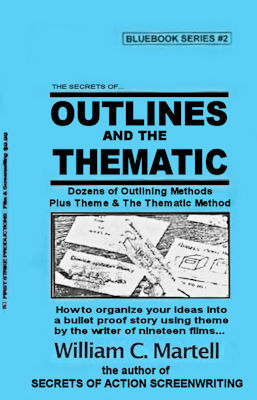
OUTLINES & THE THEMATIC Blue Book.
ARE YOUR SCENES IN THE RIGHT ORDER?
AND ARE THEY THE RIGHT SCENES?
Your story is like a road trip... but where are you going? What's the best route to get there? What are the best sights to see along the way? Just as you plan a vacation instead of just jump in the car and start driving, it's a good idea to plan your story. An artist does sketches before breaking out the oils, so why shouldn't a writer do the same? This Blue Book looks at various outlining methods used by professional screenwriters like Wesley Strick, Paul Schrader, John August, and others... as well as a guest chapter on novel outlines. Plus a whole section on the Thematic Method of generating scenes and characters and other elements that will be part of your outline. The three stages of writing are: Pre-writing, Writing, and Rewriting... this book looks at that first stage and how to use it to improve your screenplays and novels.
Only $4.99 - and no postage!
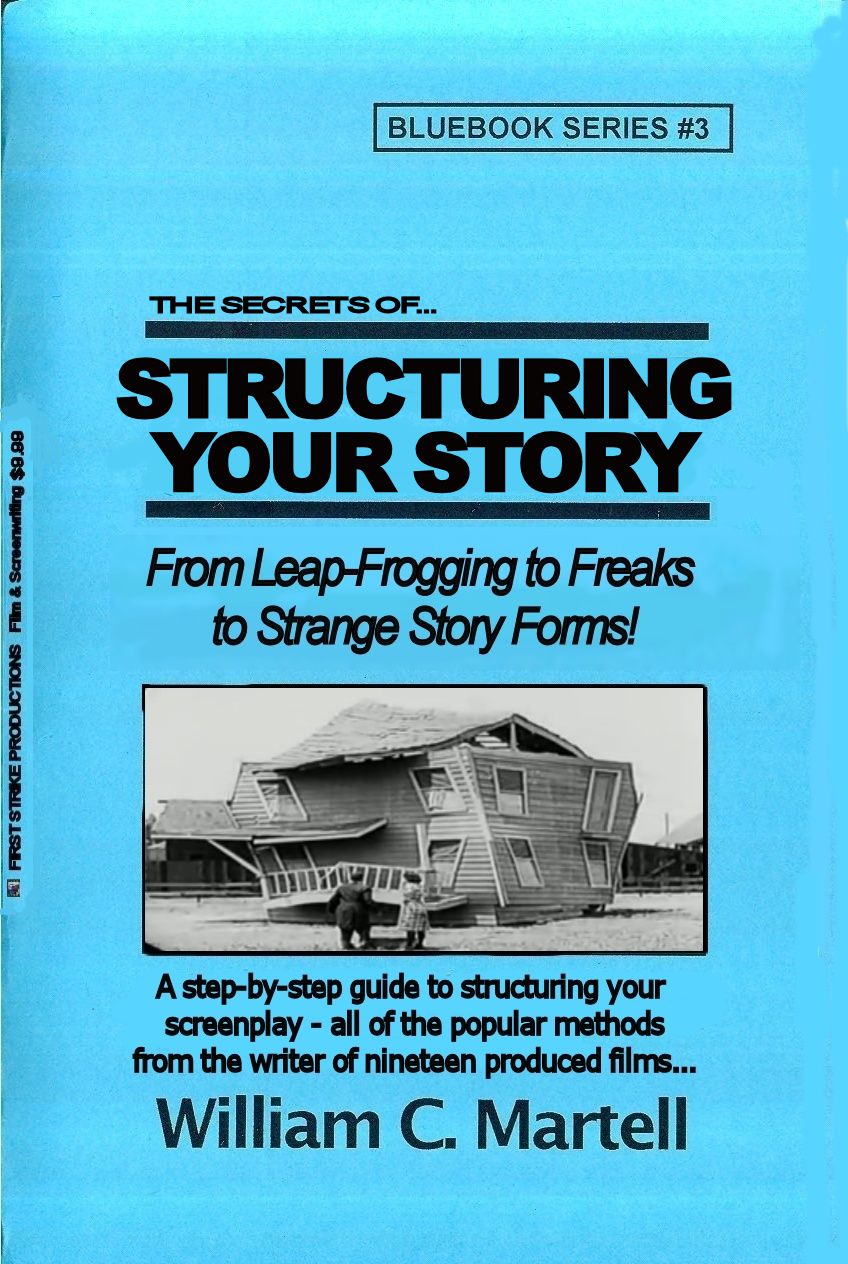
GOT STRUCTURE?!
*** STRUCTURING YOUR STORY *** - For Kindle!
William Goldman says the most important single element of any screenplay is structure. It’s the skeleton under the flesh and blood of your story. Without it, you have a spineless, formless, mess... a slug! How do you make sure your structure is strong enough to support your story? How do you prevent your story from becoming a slug? This Blue Book explores different types of popular structures from the basic three act structure to more obscure methods like leap-frogging. We also look at structure as a verb as well as a noun, and techniques for structuring your story for maximum emotional impact. Most of the other books just look at *structure* and ignore the art of *structuring* your story. Techniques to make your story a page turner... instead of a slug!
Only $4.99 - and no postage!

STORY: WELL TOLD!
*** STORY: WELL TOLD *** - For Kindle!
This book takes you step-by-step through the construction of a story... and how to tell a story well, why Story always starts with character... but ISN'T character, Breaking Your Story, Irony, Planting Information, Evolving Story, Leaving No Dramatic Stone Unturned, The Three Greek Unities, The Importance Of Stakes, The Thematic Method, and how to create personal stories with blockbuster potential. Ready to tell a story?
Print version was 48 pages, Kindle version is over 85,000 words - 251 pages!
Only $4.99 - and no postage!

START STRONG!
*** HOOK 'EM IN TEN *** - For Kindle!
Your story doesn't get a second chance to make a great first impression, and this book shows you a
bunch of techniques on how to do that. From the 12 Basic Ways To Begin Your Story, to the 3 Stars Of
Your First Scene (at least one must be present) to World Building, Title Crawls, Backstory, Starting
Late, Teasers and Pre Title Sequences, Establishing Theme & Motifs (using GODFATHER PART 2), Five Critical
Elements, Setting Up The Rest Of The Story (with GODFATHER), and much more! With hundreds of examples
ranging from Oscar winners to classic films like CASABLANCA to some of my produced films (because
I know exactly why I wrote the scripts that way). Biggest Blue Book yet!
Print version was 48 pages, Kindle version is over 100,000 words - 312 pages!
Only $4.99 - and no postage!
NO KINDLE REQUIRED! Get the *free* app (any device, except your Mr. Coffee) on the order page on Amazon!
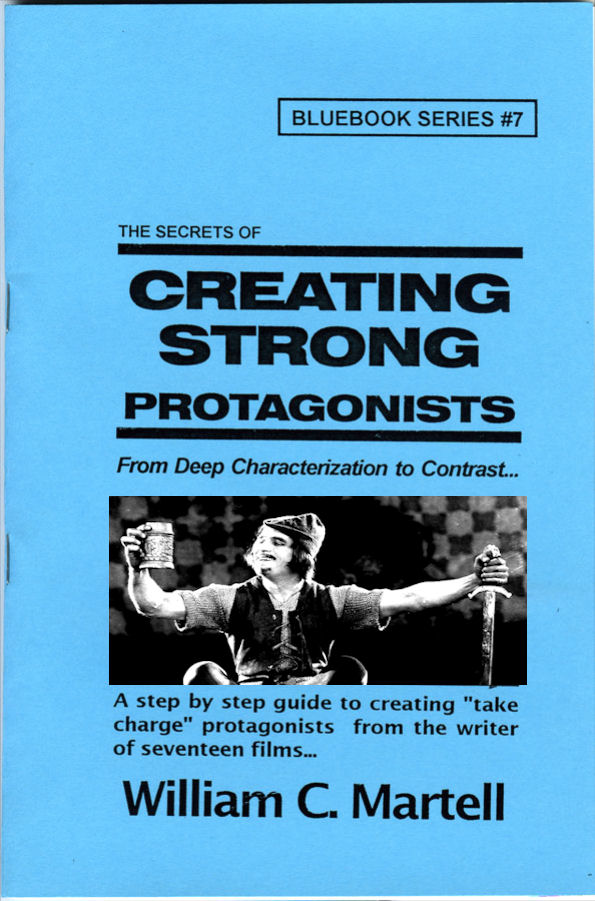
MOVIES ARE CHARACTERS!
*** CREATING STRONG PROTAGONISTS *** - For Kindle!
*** CREATING STRONG PROTAGONISTS *** - For Nook!
Expanded version with more ways to create interesting protagonists! A step-by-step guide to creating "take charge" protagonists. Screenplays are about characters in conflict... characters in emotional turmoil... Strong three dimensional protagonists who can find solutions to their problems in 110 pages. But how do you create characters like this? How do you turn words into flesh and blood? Character issues, Knowing Who Is The Boss, Tapping into YOUR fears, The Naked Character, Pulp Friction, Man With A Plan, Character Arcs, Avoiding Cliche People, Deep Characterization, Problem Protagonists, 12 Ways To Create Likable Protagonists (even if they are criminals), Active vs. Reactive, The Third Dimension In Character, Relationships, Ensemble Scripts, and much, much more. Print version is 48 pages, Kindle version is once again around 205 pages!
ONLY $4.99 - and no postage!
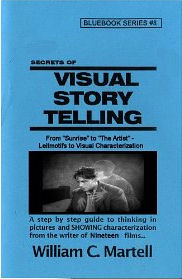
I WRITE PICTURES!
*** VISUAL STORYTELLING *** - For Kindle! (exclusive)
Show Don't Tell - but *how* do you do that? Here are techniques to tell stories visually! Using Oscar Winning Films and Oscar Nominated Films as our primary examples: from the first Best Picture Winner "Sunrise" (1927) to the Oscar Nominated "The Artist" (which takes place in 1927) with stops along the way Pixar's "Up" and Best Original Screenplay Winner "Breaking Away" (a small indie style drama - told visually) as well as "Witness" and other Oscar Winners as examples... plus RISE OF THE PLANET OF THE APES. Print version is 48 pages, Kindle version is over 200 pages!
ONLY $4.99 - and no postage!
DESCRIPTION & VOICE Blue Book!
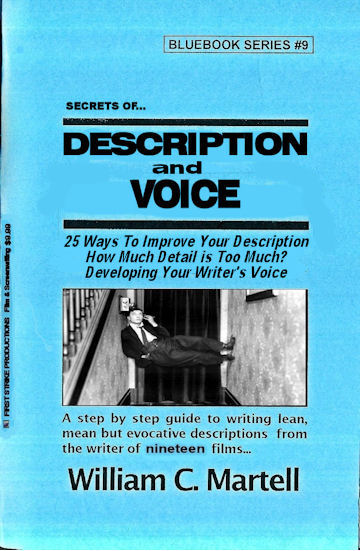
DESCRIPTION & VOICE Blue Book.
IS HALF OF YOUR STORY IN TROUBLE?
Most screenplays are about a 50/50 split between dialogue and description - which means your description is just as important as your dialogue. It just gets less press because the audience never sees it, the same reason why screenwriters get less press than movie stars. But your story will never get to the audience until readers and development executives read your script... so it is a very important factor. Until the movie is made the screenplay is the movie and must be just as exciting as the movie. So how do you make your screenplay exciting to read? Description is important in a novel as well, and the “audience” does read it... how do we write riveting description?
Only $4.99 and no postage!

PRO DIALOGUE TECHNIQUES!
*** DIALOGUE SECRETS *** - For Kindle!
***
Expanded version with more ways to create interesting dialogue! How to remove bad dialogue (and what *is* bad dialogue), First Hand Dialogue, Awful Exposition, Realism, 50 Professional Dialogue Techniques you can use *today*, Subtext, Subtitles, Humor, Sizzling Banter, *Anti-Dialogue*, Speeches, and more. Tools you can use to make your dialogue sizzle! Special sections that use dialogue examples from movies as diverse as "Bringing Up Baby", "Psycho", "Double Indemnity", "Notorious", the Oscar nominated "You Can Count On Me", "His Girl Friday", and many more! Print version is 48 pages, Kindle version is over 175 pages!
Only $4.99 - and no postage!

WHAT IS A SCENE?
*** SCENE SECRETS *** - For Kindle!
***
What is a scene and how many you will need? The difference between scenes and sluglines. Put your scenes on trial for their lives! Using "Jaws" we'll look at beats within a scene. Scene DNA. Creating set pieces and high concept scenes. A famous director talks about creating memorable scenes. 12 ways to create new scenes. Creating unexpected scenes. Use dramatic tension to supercharge your scenes. Plants and payoffs in scenes. Plus transitions and buttons and the all important "flow"... and more! Over 65,000 words! Print version was 48 pages, Kindle version is around 210 pages!
Only $4.99 - and no postage!
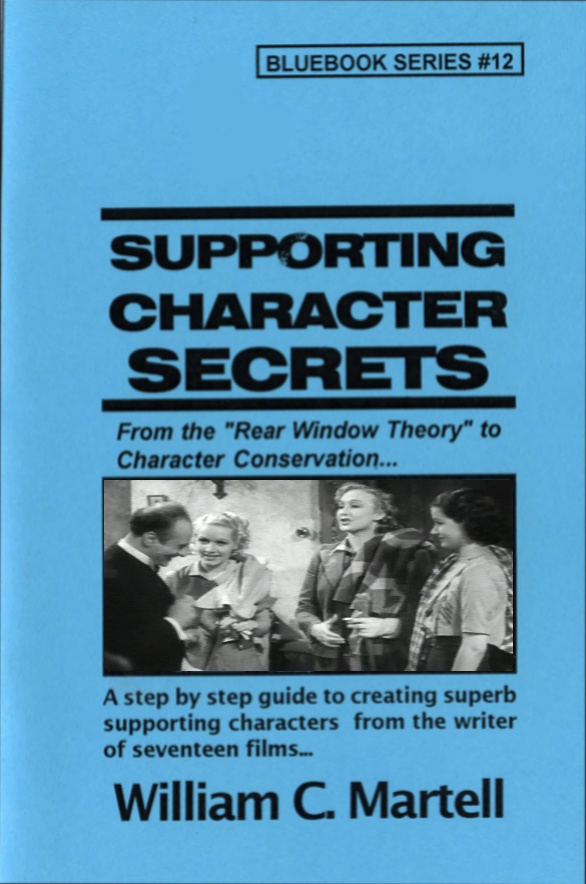
SUBPLOTS?
*** SUPPORTING CHARACTER SECRETS *** - For Kindle! (Exclusive)
Expanded version with more techniques to flesh out your Supporting Characters and make them individuals. Using the hit movie BRIDESMAIDS as well as other comedies like THE HANGOVER and TED and HIGH FIDELITY and
40 YEAR OLD VIRGIN and many other examples we look at ways to make your Supporting Characters come alive on the page.
Print version was 48 pages, Kindle version is around 170 pages!
ONLY $4.99 - and no postage!
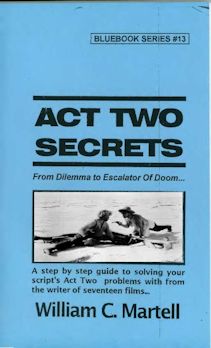
ACT TWO SOLUTIONS!
*** ACT TWO SECRETS *** - For Kindle!
Expanded version with more techniques to help you through the desert of Act Two! Subjects Include: What Is Act Two? Inside Moves, The 2 Ps: Purpose & Pacing, The 4Ds: Dilemma, Denial, Drama and Decision, Momentum, the Two Act Twos, Subplot Prisms, Deadlines, Drive, Levels Of Conflict, Escalation, When Act Two Begins and When Act Two Ends, Scene Order, Bite Sized Pieces, Common Act Two Issues, Plot Devices For Act Two, and dozens of others. Over 67,000 words (that’s well over 200 pages) of tools and techniques to get you through the desert of Act Two alive!
Print version was 48 pages, Kindle version is well over 200 pages!
ONLY $4.99 - and no postage!
All About Endings!
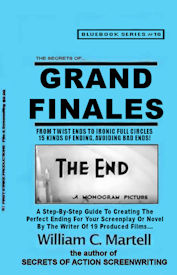
GRAND FINALES Blue Book!
The Perfect Ending For Your Story!
The First Ten Pages Of Your Screenplay Are Critical,
But What About The Last 10 Pages?
Creating the perfect ending to your story! This 100,000 word book shows you how to end your story with a bang, rather than a whimper. Everything from Resolution Order to Act Three Tools to Happy or Sad Endings? to How The Beginning Of Your Story Has Clues To The Ending (in case you were having trouble figuring out how the story should end) to Falling Action to How To Avoid Bad Endings to Writing The Perfect Twist Ending to Setting Up Sequels & Series to Emotional Resolutions to How To Write Post Credit Sequences to Avoiding Deus Ex Machinas, to 20 Different Types Of Ends (and how to write them) and much more! Everything about endings for your screenplay or novel!
Only: $4.99
NO KINDLE REQUIRED! Get the *free* app (any device, except your Mr. Coffee) on the order page on Amazon!
All About LOGLINES, TREATMENTS, and PITCHING!

LOGLINES, TREATMENTS, and PITCHING! Blue Book!
Distilling Your Screenplay!
Loglines, Treatments, Pitching, Look Books, Pitch Decks, One Pagers, Rip-O-Matics?
You have written a brilliant 110 page screenplay, but how do you get anyone to read it? You need to distill it down into some form of verbal moonshine or story rocket fuel that will ignite that bored development executive or manager or agent and get them to request your screenplay. But how do you shrink those 110 pages into a 25 word logline or a 2 minute elevator pitch or a one page synopsis or a short paragraph? This 100,000 word book shows you how! Everything you need to know! From common logline mistakes (and how to solve them) to how your pitch can reveal story problems to the 4 types of pitches!
272 Pages - ONLY $4.99!
READY TO BREAK IN?
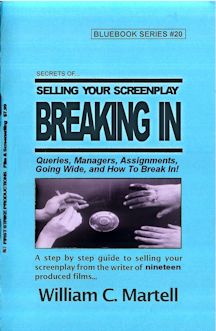
THE BUISINESS SIDE
*** BREAKING IN BLUE BOOK *** - For Kindle!
Should really be called the BUSINESS BLUE BOOK because it covers almost everything you will need to
know for your screenwriting career: from thinking like a producer and learning to speak their language,
to query letters and finding a manager or agent, to making connections (at home and in Hollywood) and
networking, to the different kinds of meetings you are will have at Studios, to the difference between
a producer and a studio, to landing an assignment at that meeting and what is required of you when you
are working under contract, to contracts and options and lawyers and... when to run from a deal!
Information you can use *now* to move your career forward! It's all here in the Biggest Blue Book yet!
Print version was 48 pages, Kindle version is over 400 pages!
$4.99 - and no postage!

Use your creative energy to focus on the content; let Final Draft take care of the style. Final Draft is the number-one selling application specifically designed for writing movie scripts, television episodics and stage plays. Its ease-of-use and time-saving features have attracted writers for almost two decades positioning Final Draft as the Professional Screenwriters Choice. Final Draft power users include Academy, Emmy and BAFTA award winning writers like Oliver Stone, Tom Hanks, Alan Ball, J.J. Abrams, James Cameron and more.
* * * Buy It!
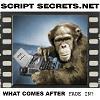
|

